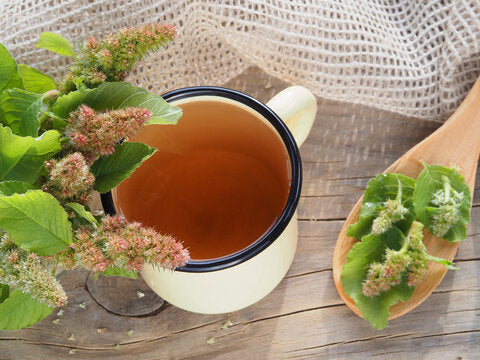

· By Doménica Palacios
The Quali-tea of Red Root Amaranth
Welcome to yet another episode of our Waku Quali-tea series, where we break down one of the ingredients in our tea blend. Native from Northern America, Red Root Amaranth is considered highly competitive due to its fast-growing, vigorous nature.The seeds are edible and can be eaten raw or cooked. They are sometimes ground into a powder and eaten as a substitute for cereal and its sprouts can be added to salads. Take a look at these fun facts, benefits and uses of Red Root Amaranth.
What is it?

Redroot pigweed, smooth pigweed, and Powell amaranth are three closely-related amaranths that have become serious cropland weeds throughout the United States and into southern Canada. The three species are discussed together because they are difficult to distinguish from one another in the field, have similar life cycles and habits of growth, and present similar management challenges in crop production.
It can be found growing in wastelands, prairies, fallow fields, farm lots, gravelly areas, and cultivated fields. Its invasiveness causes yield loss in many vegetable row crops. It grows unbranched or with minimal branches.
What are its benefits and nutritional facts?

One glossy black to dark reddish brown seed is revealed when the bladder-like capsule splits, circumferentially, at maturity. As many as 117,000 seeds can be produced per plant. The seeds may be eaten raw, or toasted. They can also be sprouted. Ground seeds can be used as a cereal. Young leaves may be eaten raw or cooked. The leaves contain vitamins A and C, iron, and calcium.
How is it used or how could it be prepared?

Use it in most of the ways you would any other edible green. For raw eating, stick with the young leaves and new shoots. These can be used like salad greens or spinach. The young and older leaves can also be sautéed or steamed, used as you would chard or turnip greens. If enjoying pigweed from your garden, be sure that you have not sprayed pesticides or herbicides on it before harvesting. Also, be aware that some varieties, like Amaranthus spinosus, have sharp spines that will need to be avoided or removed.
The organic weed management strategy outlined in the general article on pigweeds should be effective on Powell amaranth, smooth pigweed, and redroot pigweed. Try to get a positive identification of the species present, and be aware that Powell amaranth may grow more rapidly in the northern United States, and smooth pigweed more so further south. In warmer climates, positive identification is important to verify that the weed present is indeed one of these species and not Palmer amaranth or waterhemp, which are particularly aggressive in the South and the Corn Belt respectively, and may require more intensive, multi-tactic management strategies.
Adverse Effects
Pigweeds accumulate nitrates, which can lead to nitrate poisoning in grazing animals such as horses and ruminants. Mainly used for food, with both the leaves and seeds being edible. Can be poisonous to cattle and pigs in large amounts over a long period, but a nutritious fodder in small amounts.
References
What Is Pigweed – Learn About Pigweed Plant Uses
3 comments
-
I am interested to know the benifits of pigweed root tea.
Sosimo GARLEJO on
-
I am interested to know the benifits of pigweed root tea.
Sosimo GARLEJO on
-
I wish to know more about the usefulness of this redroot amaranth, if possible because it’s many as much as possible in Nigeria here but unknowingly it’s of no use.
Lawal Kamil Adeyemi on